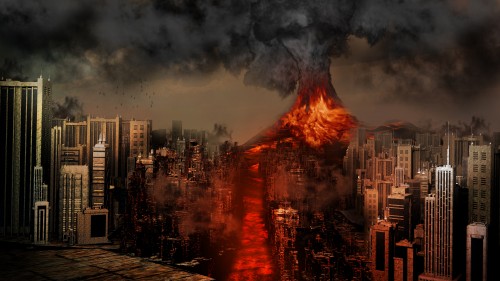 When you live in Mexico, you get used to people in other countries thinking you are in a war-zone sort of apocalypse state. If it’s not narcos, it’s earthquakes, kidnappers, or chupacabras. These days, the thing for Americans to fear in Mexico is the volcano Popocatepetl, lovingly called Popo, which is chucking ash all over the place. Notice that many reports find it necessary to give Mexico City’s population alongside reports that it’s active. As if that number might drop significantly very soon.
When you live in Mexico, you get used to people in other countries thinking you are in a war-zone sort of apocalypse state. If it’s not narcos, it’s earthquakes, kidnappers, or chupacabras. These days, the thing for Americans to fear in Mexico is the volcano Popocatepetl, lovingly called Popo, which is chucking ash all over the place. Notice that many reports find it necessary to give Mexico City’s population alongside reports that it’s active. As if that number might drop significantly very soon.
Now, for those who live here it all seems silly. I didn’t even notice the ash – though some of these reports make you think it is piling up on the sidewalks. I have noticed the air quality is a little off for the middle of rainy season (when afternoon showers clean the skies). But all in all, the rumblings of our hulking neighbor hasn’t affected me. Far more annoying is the whole since-you-live-in-Mexico-you’ll-probably-be-dead-tomorrow attitude from friends and family.
It’s really terrible and borderline racist. But … that’s not to say I won’t use it to get a story. The last time Popo was spewing ash, I decided it was a great chance to write a story tentatively called “Popo: The Most Dangerous Volcano in North America.” The story came out of a drunken conversation with a geologist at a Dylan concert near the heart of the city. A few beers in, he gave me the impression Popo was about to level the city.
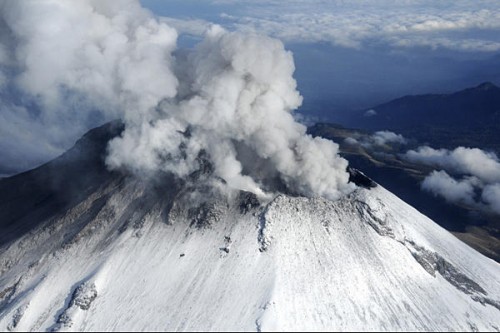
So I called up Robyn Lloyd at Scientific American and told her I had a story for her.
“Great,” she said. “I’ll take it, presuming it works out as you say it will.”
“What do you mean?” I said.
“Well, I mean, is Popocatepetl the most dangerous volcano in North America?”
“What kind of question is that?” I thought. Of course it is. It’s in Mexico and everything in Mexico is dangerous. Popo will blow and millions of people will die. Cut. Print.
Just to be sure though, I called up Randy White, a volcano expert and part of the Volcano Disaster Assistance Program, which monitors volcanoes on the continent and around the globe for USGS. White tells me that a volcano’s danger is related to a) how likely it is to explode, b) what kind of explosion it will create, and c) how many people live nearby. This can be expressed mathematically in the following equation (careful, it’s a little technical).
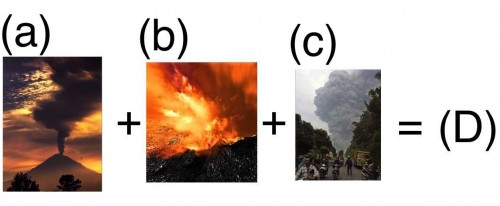
Contrary to what many news reports would have you assume, Popo is 40 miles away, not near enough to threaten Mexico City (unless lava runs uphill – it doesn’t, right?). However, it is close to Puebla, the country’s fourth largest city. And it’s certainly a little erupt-happy. So, Popo is still North America’s most dangerous volcano, right?
“Popocatepetl is not North America’s most dangerous volcano,” White says. “It doesn’t even make the list of top five. Maybe top ten, since Puebla’s right there. But really I’m not terribly worried about it.”
Great. So now my story is “Popo: Probably Among the Pretty Dangerous Volcanoes in North America. Maybe.” It seems that Popo is just too predictable to be considered a properly dangerous volcano. Like me playing poker, it’s easy to tell what Popo is about to do. Plus, it vents off all its gas rather than storing it up, waiting to explode (like a coke bottle that slowly leaks out as opposed to a sealed one that’s all shook up). If it was to stop rumbling for 20 years or so, then White says he might start to worry.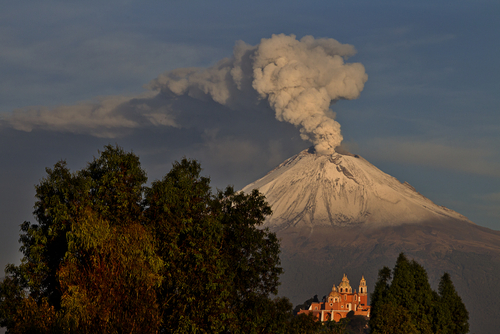
In fact, Popo is such an easy read that there’s evidence people living in Mexica (or Aztec) times actually knew when it was going to erupt, moved off the slopes of the mountain, then came back and resettled after it had calmed. Also, there’s the type of explosion. Generally speaking, thicker, more silicon-rich lava causes volcanoes to explode violently. Runnier stuff make for impressive lava squirts, like in Iceland or Hawaii, but it doesn’t tend to blanket the continent in ash like Mt St Helens did. And Popo is on the runnier side.
So I ended the conversation deflated. My Mexico (Danger! Danger!) Volcano Killing the World story was dead. But before I hung up, though, I asked White what was the most dangerous volcano in North America. He thought for a minute and then listed Mt Shasta in California and Mt. Hood in Oregon, which are unpredictable but too remote to cause much harm.
“But the one that probably keeps me up at night the most is Mt Rainier,” he finally says. It seems that not only is Rainier far more mysterious than Popo, but its chemistry points to a more viscous, explosive eruption. Plus, it hasn’t erupted in over 100 years, sitting, building up pressure. And, of course, Tacoma is right there at its foot. If it decides to get nasty, the first thing it will do is melt its snowcap, thus creating destructive landslides of slushy mud, called lahars.
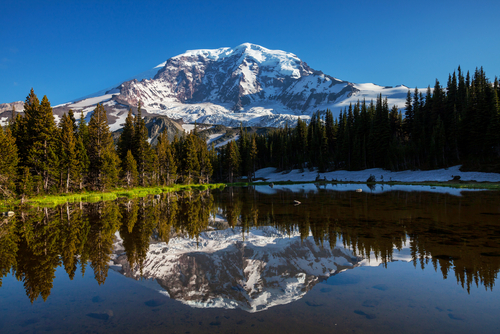
So there you have it. If you like to play it safe and avoid dangerous places and you live in Tacoma, think about relocating to Mexico City. Our volcanoes are more friendly.
Photo Credit: Shutterstock, SEMAR, Associated Press
Oh dear. It’s the Great LWON Poop-off. Who’s next??
Please tell me I didn’t misspell Popo. I was so careful…
Great article Erik.
I love Mexico City and the Volcano.
xx
M
This was a great read…i have been living in Mexico City for seven years now….recently, the volcano has been emitting a new concentration of gases (I’m no expert so Ill refrain from specifics) that indicate that thicker lava is building up below…and according to a local volcanologist who’s blog I follow, one might expect a VE 5 or 6 to result from current cycles (in a matter of weeks or in a hundred years). It does seem to be a very predictable giant though and the worst Mexico City could expect is thick ash coating, like that time a thousand years ago…
Vulcanologist blog? Who? Gimme the address! Is he a chilango?
Eric- this is the article and the blog http://volcanfire.blogspot.mx/2013/06/que-sucede-con-el-popocatepetl.html?m=1 if he isn’t a volcanologist, I apologize, he is certainly a wanna-be…in the past he has always been rather conservative, by no means a doomsdayer, so I find his recent comments intriguing. He might be chilango or poblano?….but he’s certainly local an shares information he gathers from Popo experts ( no pun intended! Lol)
This is not a blog, but the website of the Geology School of UNAM http://www.geociencias.unam.mx/geociencias/index.html I’m chilanga, I`ve read you, I’ve lived in Cholula Puebla nearby the Popocatepetl, and I like You like to write about México 🙂
Whitney, thanks for this. You’re right, it is a little more alarmed than other outlets. He seems to know more than most but his fears don’t line up with other reports. His issue about buildup of gases from water filtration was confusing. Maybe I translated that wrong. Frankly, I haven’t seen much indicating that there is much pressure available in Popo for a real explosion. The fact that the caldera is nearly full with previous layers does mean that we might see lava flowing at some point, but not explosions.
And thanks Diana! I love Cholula!
The other kinda cool thing about lahars is that they can parboil stuff in their path. And sometimes, when you come across lahars in the geologic record, there’s bits of fossilized wood and stuff preserved in them. Really cool stuff.
Oh lord, it was probably my eyes. That’s what I get when I read things before I have my morning caffeine. Apologies. Sorry for the heart attack. I really did for a second think y’all were starting a poop series. I honestly don’t think I could handle that; I’m just not mature enough.
And we are down to yellow phase II. 🙂 Thanks Eric!
Geological racism? Now you’ve done it, academics all over the place will be applying for grants to study that now.
dalecooper57, that’s not at all what I meant. I mean, well … hmm … then again, come to think of it you may be onto something.
Very good article. I thought I read once though that Yosemite was essentially one huge volcano that would erupt one day. I could be entirely wrong.
with vesuvio and campi flegrei at our neck here in europe i’d like to remind you US citizens of your ‘home’ giant volcano: yosemite. geological history tells that popo, mt. rainier, st.helens and the like are a real threat for the locals but the really large ones a threat for the entire continent.
i once climbed – or walked, rather- stromboli and was impressed by live ‘volcano action’. and felt rather small and -hm unimportant.
thanks for the post, eric
I think we are mixing up Yosemite and Yellowstone. Yosemite is a massive batholith (sp?) that has long since turned totally to stone. Yellowstone is a bubbling volcano waiting to explode. But it’s not as “dangerous” because there aren’t many people living nearby. Also, As a rock climber, I believe that the loss of Yellowstone would be nothing next to the loss of Yosemite.
On a side note, batholith and and basilisk. One is a big underground pocket of magma and one is a big snake. No idea which is which.
basilisks are these mythological creatures with a snake-like body and a cock’s head with a crown (βασιλεύς=basileus=king, ancient greek). says wikipedia, so this is solved 🙂
sorry for mixing up yosemite/yellowstone. the frightening one is yellowstone: it’s last big eruption ~600,000 y ago covered more than half of the now US states with ashes, 1-2 m high (http://swisseduc.ch/stromboli/perm/yellowstone/icons/ashfall.jpg). so it’s not only the people living close by that will be affected…
This is actually a good point. Affected and dangerous are not the same thing. Mt St Helens affected a lot of people across the country. But it only killed a few. Yellowstone, as I understand it, would be a similar scenario.
The other kinda cool thing about lahars is that they can parboil stuff in their path. And sometimes, when you come across lahars in the geologic record, there’s bits of fossilized wood and stuff preserved in them. Really cool stuff.
You mean like people still on the toilet reading the paper? I mean, some of those things move pretty fast.
Not sure if this has been stated yet, but Yellowstone would probably be listed as the most dangerous volcano in North America, if not the entire planet.
Yellowstone is a hotspot, much like Hawaii – but it’s not out in the middle of the ocean and has a lot more pressure built up. If it were to explode, or when it does – its likely to take that side of the Americas with it.
I’m not an expert, but I did ask about Yellowstone. Most scientists I talked to for this story weren’t really worried about it. I’d love to see data to the contrary, of course.
more about yellowstone can be found here: http://volcanoes.usgs.gov/volcanoes/yellowstone/index.html
looks like serious information to me.
I’ve never read your blog before, but thoroughly enjoyed your ability to relay information in a fun and easy to read way. No wonder you can just call up editors and find they’ll take your stories with only that one little caveat. And your comments “Please tell me I didn’t misspell Popo. I was so careful…”, are wonderfully witty. I’ve added your blog to my feed reader 🙂